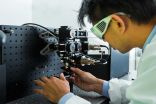Flame retardants could contribute to hyperthyroidism in older cats
2015-04-22
(Press-News.org) For years, health advocates have been pushing to ban some flame retardants for their potentially harmful effects, especially on young children and infants. Now scientists report these compounds could play a role in a common health problem for one of our most beloved pets: cats. In the ACS journal Environmental Science & Technology, a new study found that cats with hyperthyroidism had high levels of certain flame retardants, hinting at a possible link.
Jessica Norrgran and colleagues explain that more than 10 percent of older cats develop hyperthyroidism, a hormonal disorder that can cause weight loss, hyperactivity, aggression, vomiting and other symptoms. In humans, the condition has been linked to Graves' disease and iodine deficiency. No one knows for sure what causes hyperthyroidism in cats. Some studies have suggested a connection between the feline condition and flame retardants. These substances leach from plastics and furniture, and accumulate in dust that can end up on cats' fur. The animals' meticulous grooming methods make them particularly susceptible to exposure to these compounds. Norrgran's team wanted to investigate this potential link further.
The researchers tested blood samples from pet felines in Sweden -- 37 hyperthyroid cats and 23 cats with normal thyroid function. They found that those with hyperthyroidism had elevated levels of flame retardants known as polybrominated diphenyl ethers (PBDEs). Although the results don't prove that the compounds cause the disorder, the study suggests they could be linked.
INFORMATION:
The authors acknowledge funding from Stockholm University, the Swedish University of Agricultural Sciences, Uppsala, and the Swedish Research Council for Environment, Agriculture Sciences, and Spatial Planning (FORMAS).
The American Chemical Society is a nonprofit organization chartered by the U.S. Congress. With more than 158,000 members, ACS is the world's largest scientific society and a global leader in providing access to chemistry-related research through its multiple databases, peer-reviewed journals and scientific conferences. Its main offices are in Washington, D.C., and Columbus, Ohio.
To automatically receive news releases from the American Chemical Society, contact newsroom@acs.org.
Follow us: Twitter Facebook
ELSE PRESS RELEASES FROM THIS DATE:
2015-04-22
In the last 10 years, computer security researchers have shown that malicious hackers don't need to see your data in order to steal your data. From the pattern in which your computer accesses its memory banks, adversaries can infer a shocking amount about what's stored there.
The risk of such attacks is particularly acute in the cloud, where you have no control over whose applications are sharing server space with yours. An antagonist could load up multiple cloud servers with small programs that do nothing but spy on other people's data.
Two years ago, researchers in ...
2015-04-22
Tropical plantations in Southeast Asia have supplied most of the essential, natural rubber for truck, car and airplane tires for the past century. Now the tire industry and others say they're finally overcoming long-standing challenges to turn a desert shrub into an alternative source of the stretchy material. An article in Chemical & Engineering News (C&EN) explains that the latest developments will help diversify an otherwise vulnerable supply chain.
Alexander Tullo, a senior correspondent at C&EN, explains that natural rubber has unique properties that make it ideal ...
2015-04-22
Rapidly swinging from extremes of joy and energy to sadness, fatigue, and confusion, bipolar disorder (BD) patients feel desperate and largely alone in the world. And according to the National Institutes of Health, between 25-50 percent of the roughly 3% of Americans living with BD attempt suicide at least once. Lithium is among the most effective therapies for BD, and remains the first-line treatment even as other mood stabilizing drugs have become available. But about half of the patients prescribed lithium do not respond to the treatment.
A new Tel Aviv University ...
2015-04-22
TORONTO, April 22, 2015 -- A genetic test that can prevent 'killer' bees from spreading around the world has been created in a research effort led by University of Sydney scholars jointly with York University scientists.
"Our genetic test is highly accurate and considerably more sophisticated than the old tests that have a high tendency to misclassify hybrid bees," says Professor Amro Zayed in the department of Biology, Faculty of Science.
Africanized honeybees are highly aggressive and very difficult to manage relative to European honeybees used by Canadian and Australian ...
2015-04-22
In the most comprehensive study ever on the impact of smoking on cardiovascular disease in older people, epidemiologist Dr. Ute Mons from the German Cancer Research Center (Deutsches Krebsforschungszentrum, DKFZ) analyzed 25 individual studies, compiling data from over half a million individuals age 60 and older.
Twice as many smokers die from cardiovascular disease than life-long non-smokers do. The increase in risk depends on the number of cigarettes that a person has smoked in his or her lifetime. After one quits smoking, this risk continues to decrease. On average, ...
2015-04-22
In the quantum world of light, being distinguishable means staying lonely. Only those photons that are indistinguishable can wind up in a pair, through what is called Hong-Ou-Mandel interference. This subtle quantum effect has been successfully imaged for the first time by two doctoral students from the Faculty of Physics at the University of Warsaw.
Physicists have long known that photons can become bunched together. However, technological limitations have prevented the phenomenon from actually being observed directly. Only recently has this feat been achieved by two ...
2015-04-22
Bethesda, MD, April 20, 2015: The Association for Molecular Pathology (AMP), the premier global, non-profit organization serving molecular diagnostic professionals, today published a special article in The Journal of Molecular Diagnostics titled, "Do Circulating Tumor Cells, Exosomes, and Circulating Tumor Nucleic Acids Have Clinical Utility?" The report provides a thorough overview of research to-date on the minimally invasive "liquid biopsy" approaches to cancer diagnostics.
"As a group of molecular diagnostic experts, we were intrigued and excited by the emerging ...
2015-04-22
Hasbro Children's Hospital study finds link between adverse childhood experiences and pediatric asthma
Children who experience violence, substance abuse at home
report significantly higher rates of asthma
PROVIDENCE, R.I. - Robyn Wing, M.D., an emergency medicine physician at Hasbro Children's Hospital, recently led a study that found children who were exposed to an adverse childhood experience (ACE) were 28 percent more likely to develop asthma. The rate of asthma occurrence further increased in children with each additional ACE exposure. The study, recently published ...
2015-04-22
Scientists have for the first time captured live images of the process of taste sensation on the tongue.
The international team imaged single cells on the tongue of a mouse with a specially designed microscope system.
"We've watched live taste cells capture and process molecules with different tastes," said biomedical engineer Dr Steve Lee, from The Australian National University (ANU).
There are more than 2,000 taste buds on the human tongue, which can distinguish at least five tastes: salty, sweet, sour, bitter and umami.
However the relationship between the ...
2015-04-22
Rather than slowing down, ants speed up in response to a higher density of traffic on their trails, according to new research published in Springer's journal The Science of Nature - Naturwissenschaften. When the researchers increased the supply of food by leaving food next to the trail, ants accelerated their speed by 50 percent. This was despite more than double the density of traffic.
When food increases in supply, more forager ants are sent out to carry it back to the nest. With this increase in ant density, the number of encounters between outbound and incoming individuals ...
LAST 30 PRESS RELEASES:
[Press-News.org] Flame retardants could contribute to hyperthyroidism in older cats

